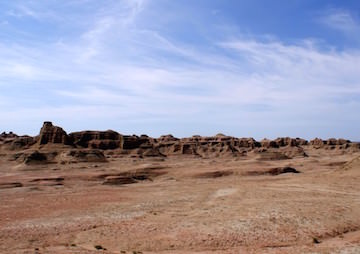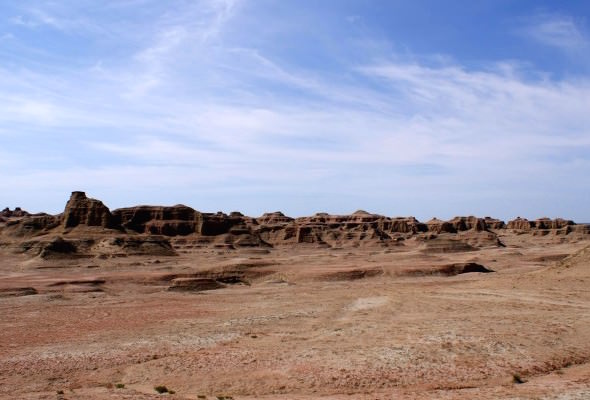Spread of Drylands Will Hit Poorer Nations Hardest
Global warming, increasing aridity and a rapidly expanding human population will lead to drylands covering half of the earth’s land surface by the end of this century.
By Tim Radford / Climate News Network

Drylands are among the areas most sensitive to climate change and human activities. (Haipeng Yu / Lanzhou University)
This Creative Commons-licensed piece first appeared at Climate News Network.
LONDON — If global greenhouse gas emissions continue to rise, the outlook for at least half the inhabited planet looks arid. By 2100, according to new research, at least half — and perhaps as much as 56% — of the land surface of the planet will be classified as dryland.
Dryland, to a geographer, is not desert: it is terrain on which rain certainly falls, but rainfall is balanced by evaporation and transpiration through plant tissues. That is, dryland offers a precarious living to a sparse population.
It doesn’t take much — overgrazing, erosion, ambitious cropping — to tip the balance and turn the land into desert. Right now, 38% of humanity makes a living on the drylands.
So the report in Nature Climate Change by atmospheric scientist Jianping Huang and colleagues at Lanzhou University in China that under global warming scenarios, drylands are to expand is very bad news for those who are already among the poorest in the world.
Climate simulations
That is because 78% of expansion of drylands — and 50% of the planet’s population growth — will occur in the developing countries.
Climate scientists have already predicted that, in a warming world, arid regions are likely to get even less rain, while humid ones could be at greater risk of flooding.
Professor Huang and his colleagues took two climate simulations and projected them backwards in time, and forwards — the first to check the simulation against recorded data from the period 1961-1990, and then to fine-tune the future projections.
They found that climate models so far have underestimated the global trends in drying regions. Temperatures will rise, and so will levels of aridity.
But as population will also rise, along with pressure on existing farm and rangeland, so will the risk that ever greater areas of the drylands will become degraded and, in effect, desert lands.
“These results imply that the survival
environment in developing countries
will be more vulnerable.”
Some of the increasing drylands will be in eastern Siberia, Alaska and north-west Canada. Northeastern China will also be affected.
The report says: “In the late 21st century, the extent of the drier areas increases, and the drylands cover nearly all of the continental areas of Africa and Eurasia between 30° to 60°N and 15° to 50°S and western North America. Thus, drylands dominate the global land surface.
“These results support previous studies that the aridity changes over land have not simply followed the ‘dry gets drier, wet gets wetter’ paradigm.”
The same study confirms that 78% of the increased dryland occurs in developing countries. It says: “These results imply that the survival environment in developing countries will be more vulnerable.”
Warming trends
These are computer simulations of an unknowable future. Precisely what will happen, and how, is necessarily uncertain. But the projections are uncompromising, and the authors suggest that the actual outcome could be even worse.
Under one scenario, drylands increase by 11%, under the other by 23%. By the end of this century, drylands will cover 50% or 56% of the terrestrial globe. The warming trends over the drylands are twice as great as those over the humid regions, which once again amplifies the pattern of aridity.
The developed world will be affected, but the developing world will be hurt even more, by increasing aridity, greater temperatures and faster population growth.
“The same temperature rise will probably have a greater effect on the poor and vulnerable populations inhabiting the drylands, leading to increased poverty, degradation of the land and ecosystems, soil loss and further desertification,” the scientists warn.
“By 2025, drylands may occupy 48% of the global land surface and sustain 51% of the global population growth from 2000 to 2025 — 50% of which will occur in developing countries, compared with only 1% in developed countries.”
Tim Radford, a founding editor of Climate News Network, worked for The Guardian for 32 years, for most of that time as science editor. He has been covering climate change since 1988.
Your support matters…Independent journalism is under threat and overshadowed by heavily funded mainstream media.
You can help level the playing field. Become a member.
Your tax-deductible contribution keeps us digging beneath the headlines to give you thought-provoking, investigative reporting and analysis that unearths what's really happening- without compromise.
Give today to support our courageous, independent journalists.







You need to be a supporter to comment.
There are currently no responses to this article.
Be the first to respond.